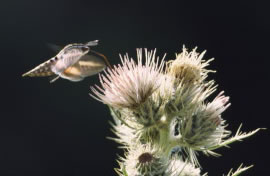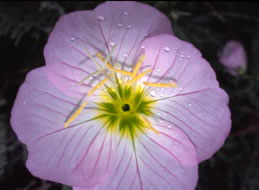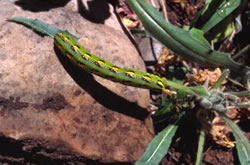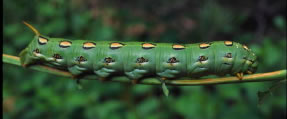 Hovering
around the edge of dusk, a moth darts in and among the bed
of Mexican evening primroses. Barely visible due to the impending
twilight, I attempt to trace its path, its seemingly random
flights between flowers. This moth does not labor like the
others, with ponderous wings and erratic flight. No, it moves
more like a hummingbird than a moth, its 3-inch long wings
giving providing forward and backward movements that are punctuated
by short periods of hovering. Hovering
around the edge of dusk, a moth darts in and among the bed
of Mexican evening primroses. Barely visible due to the impending
twilight, I attempt to trace its path, its seemingly random
flights between flowers. This moth does not labor like the
others, with ponderous wings and erratic flight. No, it moves
more like a hummingbird than a moth, its 3-inch long wings
giving providing forward and backward movements that are punctuated
by short periods of hovering.
Though it is getting dark, I can image the long proboscis of this moth
probing the flowers for their sweet nectar. The plant, a member of the
Onagraceae or Evening Primrose Family, has a long floral tube that requires
a pollinator to posses a long proboscis to reach its nectar rewards.
Sphinx moths have a 4-inch proboscis that they unfurl and slip into these
floral throats. The pollinator then siphons up the sweet fluid through
this  tongue-like
appendage, then proceeds to the next flower. When it departs, the moth
carries a bit of pollen that has been dusted upon its forehead by the
flower’s stamens. As the moth sticks its head into the next flower,
this pollen comes in contact the flower’s style – the female
structure that “captures” the pollen. The moth’s chore
of pollination is done, and then repeated over and over again as it forages
for nectar. tongue-like
appendage, then proceeds to the next flower. When it departs, the moth
carries a bit of pollen that has been dusted upon its forehead by the
flower’s stamens. As the moth sticks its head into the next flower,
this pollen comes in contact the flower’s style – the female
structure that “captures” the pollen. The moth’s chore
of pollination is done, and then repeated over and over again as it forages
for nectar.
If the particular moth
is a female, she may also be on the lookout for a suitable
host plant. She will lay numerous eggs on the undersides
of leaves. Tiny as a pinhead, the green eggs appear bolted
to the leaf. When the larvae inside is ready to emerge, it
enters into a world of sunshine, unless it comes out at night.
 The
caterpillar period goes through several molts called “instars” as
the larvae consumes the leaves of its host plant.
In my garden, evening primroses and tomatoes serve
as luncheonettes for these voracious eaters. I
once read that during wet springs when there are
abundant larvae, one can hear the chewing from
several feet away. The
caterpillar period goes through several molts called “instars” as
the larvae consumes the leaves of its host plant.
In my garden, evening primroses and tomatoes serve
as luncheonettes for these voracious eaters. I
once read that during wet springs when there are
abundant larvae, one can hear the chewing from
several feet away.
Sphinx moths and their near relatives have sleek green bodies lined with
dots or marks. A fleshy process near their posterior is responsible the
sphinx portion of their common name or the non-charismatic common name:
hornworm. Never mind that the “horn” is at their rump, one
relative of the sphinx moth gets a bad reputation due to their preference
for tomato leaves. But just as the ugly cygnet turns into the beautiful
swan, so too will this garden demon transform into a graceful night flyer.
 After
the larvae go through several growth stages, they are ready to
pupate. Most crawl down the stem and burrow underground in late
summer or early fall. Here they overwinter, awaiting warmer weather
and the transformation into an adult. As spring rolls around,
the larvae wiggle closer to the surface before they pupate. That
way when the adults emerge they are just below the ground surface. After
the larvae go through several growth stages, they are ready to
pupate. Most crawl down the stem and burrow underground in late
summer or early fall. Here they overwinter, awaiting warmer weather
and the transformation into an adult. As spring rolls around,
the larvae wiggle closer to the surface before they pupate. That
way when the adults emerge they are just below the ground surface.
Though the adults are active mostly in the evening, they do come out
in the day. These moths specialize in night blooming plants like datura,
four o’clock, and evening primroses, and yet they feed on a wide
variety of plants that bloom in the day. The moths aren’t selective
like yucca moths, but they require flowers with high sugar contents to
their nectar.
As the daylight fades and night flushes out the sky, I lose sight of
these moths. With their spindle-shaped antennae and short, broad wings,
I’m sure they are still out their feeding as they hover around
the edge of darkness.

|

 Hovering
around the edge of dusk, a moth darts in and among the bed
of Mexican evening primroses. Barely visible due to the impending
twilight, I attempt to trace its path, its seemingly random
flights between flowers. This moth does not labor like the
others, with ponderous wings and erratic flight. No, it moves
more like a hummingbird than a moth, its 3-inch long wings
giving providing forward and backward movements that are punctuated
by short periods of hovering.
Hovering
around the edge of dusk, a moth darts in and among the bed
of Mexican evening primroses. Barely visible due to the impending
twilight, I attempt to trace its path, its seemingly random
flights between flowers. This moth does not labor like the
others, with ponderous wings and erratic flight. No, it moves
more like a hummingbird than a moth, its 3-inch long wings
giving providing forward and backward movements that are punctuated
by short periods of hovering.  tongue-like
appendage, then proceeds to the next flower. When it departs, the moth
carries a bit of pollen that has been dusted upon its forehead by the
flower’s stamens. As the moth sticks its head into the next flower,
this pollen comes in contact the flower’s style – the female
structure that “captures” the pollen. The moth’s chore
of pollination is done, and then repeated over and over again as it forages
for nectar.
tongue-like
appendage, then proceeds to the next flower. When it departs, the moth
carries a bit of pollen that has been dusted upon its forehead by the
flower’s stamens. As the moth sticks its head into the next flower,
this pollen comes in contact the flower’s style – the female
structure that “captures” the pollen. The moth’s chore
of pollination is done, and then repeated over and over again as it forages
for nectar. The
caterpillar period goes through several molts called “instars” as
the larvae consumes the leaves of its host plant.
In my garden, evening primroses and tomatoes serve
as luncheonettes for these voracious eaters. I
once read that during wet springs when there are
abundant larvae, one can hear the chewing from
several feet away.
The
caterpillar period goes through several molts called “instars” as
the larvae consumes the leaves of its host plant.
In my garden, evening primroses and tomatoes serve
as luncheonettes for these voracious eaters. I
once read that during wet springs when there are
abundant larvae, one can hear the chewing from
several feet away. After
the larvae go through several growth stages, they are ready to
pupate. Most crawl down the stem and burrow underground in late
summer or early fall. Here they overwinter, awaiting warmer weather
and the transformation into an adult. As spring rolls around,
the larvae wiggle closer to the surface before they pupate. That
way when the adults emerge they are just below the ground surface.
After
the larvae go through several growth stages, they are ready to
pupate. Most crawl down the stem and burrow underground in late
summer or early fall. Here they overwinter, awaiting warmer weather
and the transformation into an adult. As spring rolls around,
the larvae wiggle closer to the surface before they pupate. That
way when the adults emerge they are just below the ground surface.